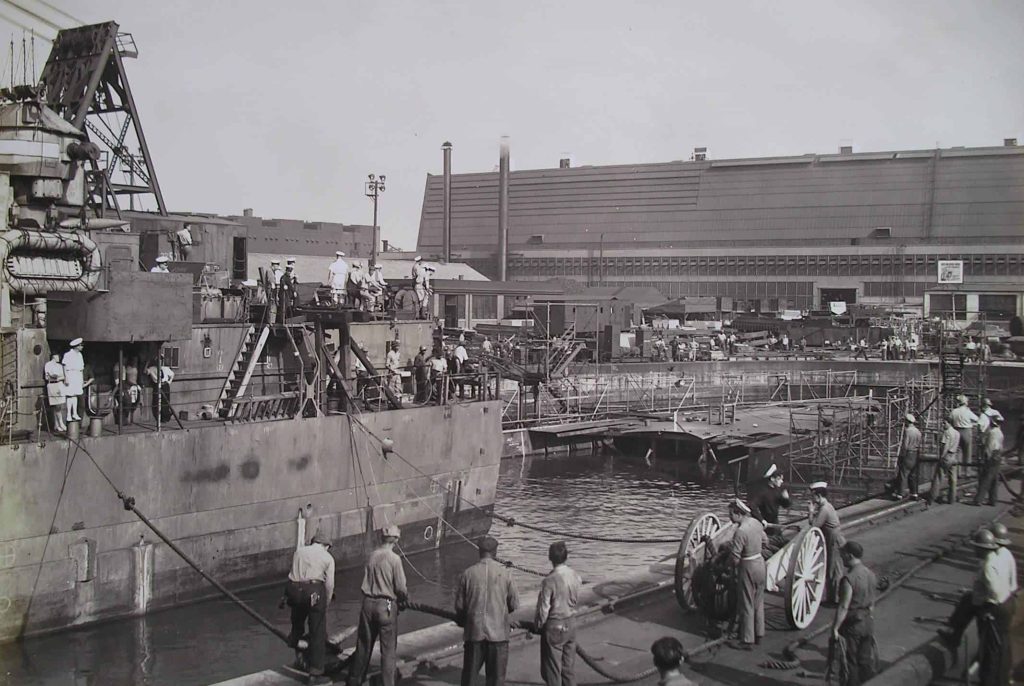On December 13th, a naval operation took place involving the vessels HMS Aurora, HMS Eskimo, HMS Quality, and the recently joined Argonaut. Their objective was to intercept an Axis convoy, but due to delays in setting sail, they unfortunately missed the convoy. The events took a dramatic turn on December 14th, 1942 at 06:00 when HMS Argonaut was struck by two torpedoes launched by the Italian Submarine Mocenigo. The impact caused severe damage, resulting in the destruction of both the ship’s bow and stern. Additionally, during the aftermath of the attack, Argonaut came under an aerial assault, narrowly escaping a direct hit on its starboard quarter. Tragically, three crew members lost their lives in the explosion.
Despite the daunting challenges posed by the damage and continuous aerial harassment, the ship valiantly navigated its way to Gibraltar via Algiers, albeit with only two of its four propellers operational. The severity of the damage was such that a makeshift bow constructed in Gibraltar proved ineffective. The German forces, believing that the Argonaut had been sunk, even reported its demise on German Radio. In response to this announcement by the Axis, the National Savings Committee revealed that the City of Coventry had raised an impressive sum of £2,250,000 to fund the replacement of the Argonaut.

After the devastating attack that left HMS Argonaut severely damaged, plans were made for her repairs to take place in Philadelphia, United States of America. However, the journey to reach the American shores meant traversing the treacherous waters of the U-boat-infested Atlantic Ocean. On April 4th, 1943, with a new Commanding Officer, Captain Haynes RN, at the helm, HMS Argonaut departed from Gibraltar. Accompanying her was the escort ship HMS Hero. Together, they set course for their first stop, Ponta Delgada, situated on the Portuguese islands of the Azores.
Under the guidelines of the World Government Convention, which allowed war-engaged vessels to seek refuge in neutral ports for up to three days for essential repairs, HMS Argonaut arrived in Ponta Delgada. However, the crew was surprised to discover a German U-boat docked nearby, undergoing its own repairs. The presence of the enemy vessel raised tensions and concerns among the crew. On April 8th, just a few hours after the German U-boat’s departure, HMS Argonaut set sail once again. Anticipating a potential attack, the crew prepared for a confrontation with the enemy vessel, while HMS Hero conducted an Anti-Submarine Warfare (ASW) sweep to ensure the safety of their journey. Thankfully, no hostilities occurred during this encounter.
Unfortunately, HMS Hero experienced engine issues and was detached from the mission on April 9th, leaving HMS Argonaut to make the transatlantic crossing on her own. However, on April 13th, a ray of hope appeared on the horizon as USS Butler was spotted and joined the voyage, providing much-needed assistance and camaraderie. The two ships sailed together and reached the port of Bermuda on April 17th, where further repairs were carried out on the hull of HMS Argonaut.
With the necessary repairs completed, HMS Argonaut once again embarked on her journey. On April 27th, under the escort of USS Tumult and USS Pioneer, the ship set sail from Bermuda, bound for the port of Philadelphia. It was a challenging voyage, navigating through the vast expanse of the Atlantic Ocean, but the combined efforts of the crew and the escort ships ensured the safety of HMS Argonaut. Finally, on April 30th, 1943, the ship arrived at the port of Philadelphia, ready for the extensive repairs that awaited her.
The arrival of HMS Argonaut in Philadelphia marked a significant milestone in her journey to restoration. The ship’s resilience and the support received from Allied forces showcased the determination and unity in the face of adversity. The repairs that would soon commence in the United States would breathe new life into the vessel, allowing her to once again contribute to the ongoing efforts in the war against the Axis powers.


